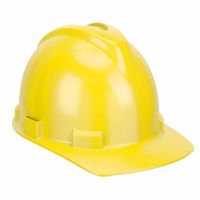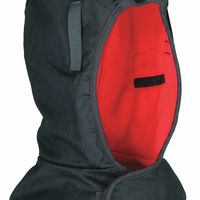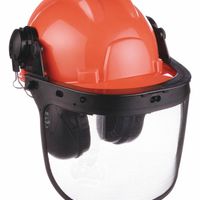Call +(254) 703 030 000 / 751 483 999 / 721 704 777
.....Read More
Frequently Asked Questions
What is the difference between a hard hat and a bump cap?
A hard hat and a bump cap are both types of head protection used in different environments, but they serve distinct purposes and offer varying levels of protection.
A hard hat is designed to protect against high-impact hazards. It is typically made from durable materials like high-density polyethylene (HDPE) or fiberglass and features a suspension system inside that helps absorb and distribute the force of an impact. Hard hats are used in construction, mining, and other industrial settings where there is a risk of falling objects, electrical hazards, or other serious head injuries. They often come with additional features such as chin straps, visors, and earmuffs for enhanced protection.
In contrast, a bump cap is intended for low-impact protection. It is usually made from lightweight materials like plastic or foam and is designed to protect the wearer from minor bumps and scrapes. Bump caps are commonly used in environments like warehouses, maintenance areas, or any setting where there is a risk of bumping one's head against stationary objects. They do not have the same level of impact resistance as hard hats and are not suitable for environments with falling object hazards.
In summary, the primary difference between a hard hat and a bump cap lies in their intended use and level of protection. Hard hats are for high-impact protection in hazardous environments, while bump caps are for low-impact protection in less dangerous settings.
When is head protection required by OSHA?
Head protection is required by OSHA when there is a potential for head injuries due to falling objects, bumps to the head from fixed objects, or accidental head contact with electrical hazards. Specifically, OSHA's standard 29 CFR 1910.135 mandates that employers must ensure employees wear protective helmets in areas where there is a risk of head injury from falling objects. Additionally, helmets designed to reduce electrical shock hazards must be worn when employees are exposed to electrical conductors that could contact the head.
Employers are responsible for assessing the workplace to determine if hazards are present or likely to be present, which necessitate the use of head protection. This assessment should consider various factors, including the nature of the work, the environment, and the potential for accidents. If such hazards are identified, appropriate head protection must be provided and used.
OSHA also requires that the protective helmets comply with the American National Standards Institute (ANSI) standards, specifically ANSI Z89.1, which classifies helmets by the type of protection they offer, such as impact and electrical protection. Employers must ensure that the helmets are properly fitted, maintained, and replaced when necessary to provide adequate protection.
In summary, head protection is required by OSHA in any work environment where there is a risk of head injury from physical or electrical hazards. Employers must conduct a hazard assessment and provide ANSI-compliant helmets to ensure the safety of their employees.
How do I choose the right size hard hat?
To choose the right size hard hat, follow these steps:
1. **Measure Your Head Circumference**: Use a flexible tape measure to determine the circumference of your head. Position the tape about an inch above your eyebrows and ears, ensuring it is level all around.
2. **Consult the Manufacturer's Sizing Chart**: Different manufacturers may have varying sizing standards. Refer to the specific sizing chart provided by the hard hat manufacturer to match your head measurement with the correct size.
3. **Consider Adjustability**: Many hard hats come with adjustable suspension systems, such as ratchet or pin-lock mechanisms. These allow for minor adjustments to ensure a snug fit. Choose a hard hat with an adjustable system for better comfort and fit.
4. **Try It On**: If possible, try on the hard hat before purchasing. It should sit comfortably on your head without being too tight or too loose. The hat should not move excessively when you shake your head.
5. **Check for Proper Coverage**: Ensure the hard hat covers the top of your head and extends down to protect the sides and back. It should sit about an inch above your eyebrows.
6. **Test for Stability**: Once adjusted, the hard hat should remain stable and not shift easily when you move your head. It should feel secure without causing pressure points.
7. **Consider Additional Features**: If you need to wear accessories like earmuffs or face shields, ensure the hard hat is compatible with these attachments.
8. **Review Safety Standards**: Ensure the hard hat meets relevant safety standards (e.g., ANSI/ISEA Z89.1 in the U.S.) for your specific work environment.
By following these steps, you can select a hard hat that provides optimal protection and comfort.
Can hard hats be customized with accessories like headlamps and chinstraps?
Yes, hard hats can be customized with accessories like headlamps and chinstraps. Many hard hats are designed with slots or attachment points that allow for the addition of various accessories to enhance functionality and safety.
Headlamps are a common accessory for hard hats, especially in industries where workers need to operate in low-light conditions. These headlamps can be clipped onto the brim or attached via a strap that wraps around the hard hat. Some hard hats come with built-in mounts specifically designed for headlamps, ensuring a secure fit and optimal lighting direction.
Chinstraps are another accessory that can be added to hard hats to improve safety. They help keep the hard hat securely in place, especially in environments where there is a risk of the hat being knocked off, such as in windy conditions or when working at heights. Chinstraps can be easily attached to the hard hat through designated attachment points or clips.
Other accessories that can be added to hard hats include visors, earmuffs, and neck shades. Visors provide additional face protection, earmuffs offer hearing protection, and neck shades protect against sun exposure.
When customizing hard hats with accessories, it is important to ensure that the accessories are compatible with the specific model of the hard hat and that they do not compromise the safety standards of the helmet. Manufacturers often provide guidelines and compatible accessory options to ensure that the hard hat maintains its protective capabilities.
How often should hard hats be replaced?
Hard hats are crucial for head protection in various work environments, and their replacement is essential to ensure safety. The general guideline for replacing hard hats is every five years, regardless of their appearance, as recommended by most manufacturers and safety organizations. However, this timeline can vary based on several factors, including the work environment, frequency of use, and exposure to harsh conditions.
For hard hats used in environments with extreme temperatures, chemical exposure, or direct sunlight, the replacement period may be shorter. Ultraviolet (UV) radiation can degrade the plastic materials, making them brittle and less effective. In such cases, it is advisable to replace the hard hat every two to three years.
Additionally, the suspension system inside the hard hat, which absorbs impact, should be replaced more frequently, typically every 12 months, or sooner if it shows signs of wear and tear. Regular inspection of the hard hat is crucial. Look for cracks, dents, or any signs of damage on the shell and suspension system. If any damage is detected, the hard hat should be replaced immediately, regardless of its age.
Some hard hats come with a date stamp indicating the date of manufacture. This can help track the age of the hard hat and determine when it should be replaced. It is also important to follow the manufacturer's specific guidelines and recommendations for replacement, as they may vary based on the materials and design of the hard hat.
In summary, while the standard replacement period for hard hats is every five years, factors such as environmental conditions and usage frequency can necessitate more frequent replacements. Regular inspections and adherence to manufacturer guidelines are key to ensuring optimal protection.
What materials are hard hats made from?
Hard hats are primarily made from materials that offer durability, impact resistance, and comfort. The most common materials used include:
1. **High-Density Polyethylene (HDPE):** This is the most widely used material for hard hats due to its excellent balance of strength, lightweight properties, and cost-effectiveness. HDPE provides good impact resistance and is suitable for a variety of environments.
2. **Acrylonitrile Butadiene Styrene (ABS):** ABS is known for its toughness and resistance to impact and chemicals. It is slightly heavier than HDPE but offers superior durability and is often used in environments where higher impact resistance is required.
3. **Fiberglass:** Fiberglass hard hats are known for their high heat resistance and are often used in environments with extreme temperatures. They are heavier than plastic-based hard hats but provide excellent protection against heat and electrical hazards.
4. **Polycarbonate:** This material is used for its high impact resistance and clarity. Polycarbonate hard hats are often used in environments where visibility is crucial, such as in construction sites with low lighting.
5. **Aluminum:** Although less common, aluminum hard hats are used in specific industries where metal detection is not an issue. They offer good impact resistance and are lightweight, but they conduct electricity, making them unsuitable for electrical work.
Each material is chosen based on the specific requirements of the work environment, such as exposure to heat, chemicals, or electrical hazards. The choice of material affects the hard hat's weight, comfort, and level of protection, ensuring that workers are adequately protected in their specific work conditions.
Are there different types of hard hats for different industries?
Yes, there are different types of hard hats designed for various industries, each tailored to meet specific safety requirements and environmental conditions. Hard hats are classified based on their construction, material, and the level of protection they offer.
1. **Type I and Type II**:
- **Type I** hard hats are designed to protect against impacts to the top of the head. They are commonly used in construction and general industry.
- **Type II** hard hats provide protection against both top and lateral impacts, making them suitable for environments where side impacts are a risk, such as in logging or mining.
2. **Classifications**:
- **Class G (General)**: These hard hats provide impact protection and are tested for electrical protection up to 2,200 volts. They are used in construction and manufacturing.
- **Class E (Electrical)**: Offering the highest level of electrical protection, these hard hats are tested up to 20,000 volts and are used by electricians and utility workers.
- **Class C (Conductive)**: These hard hats do not provide electrical protection and are used in environments where electrical hazards are not a concern, such as in certain manufacturing settings.
3. **Special Features**:
- **Vented Hard Hats**: Designed for better airflow, these are used in hot environments to keep workers cool.
- **Full-Brim Hard Hats**: Provide additional protection from sun and rain, often used in outdoor settings.
- **Bump Caps**: Offer minimal protection and are used in environments with low head clearance but no risk of falling objects.
Different industries require specific hard hat features to address unique hazards, ensuring worker safety and compliance with occupational safety standards.
How do I properly adjust a hard hat for a secure fit?
1. **Select the Right Size**: Choose a hard hat that fits your head size. Most hard hats come with adjustable suspension systems to accommodate different head sizes.
2. **Inspect the Hard Hat**: Before adjusting, ensure the hard hat is in good condition. Check for cracks, dents, or any signs of wear and tear.
3. **Adjust the Suspension System**:
- **Headband**: Locate the headband inside the hard hat. Most hard hats have a ratchet or pin-lock system.
- **Ratchet System**: Turn the knob at the back of the headband to tighten or loosen the fit.
- **Pin-Lock System**: Adjust by inserting the pin into the appropriate hole for a snug fit.
4. **Position the Hard Hat**: Place the hard hat on your head so that it sits level and covers the top of your head. The brim should be parallel to the ground.
5. **Adjust the Chin Strap (if available)**: If your hard hat has a chin strap, adjust it so it fits snugly under your chin without being too tight.
6. **Check the Fit**:
- The hard hat should feel secure but comfortable.
- It should not move excessively when you shake your head.
- Ensure there is a gap between the shell and your head for impact absorption.
7. **Test the Fit**:
- Bend over and shake your head. The hard hat should stay in place.
- Adjust further if necessary.
8. **Recheck Regularly**: Periodically check the fit and condition of your hard hat, especially if you change hairstyles or wear additional headgear.
9. **Follow Manufacturer’s Instructions**: Always refer to the manufacturer’s guidelines for specific adjustment instructions and safety recommendations.
What are the safety standards for head protection equipment?
Safety standards for head protection equipment, such as helmets and hard hats, are designed to minimize the risk of head injuries in various environments. Key standards include:
1. **ANSI/ISEA Z89.1 (USA):** This standard classifies helmets into Type I (top impact) and Type II (top and lateral impact) and further categorizes them by electrical protection: Class G (general), Class E (electrical), and Class C (conductive). Helmets must pass impact, penetration, and electrical insulation tests.
2. **EN 397 (Europe):** This standard specifies requirements for industrial safety helmets, including shock absorption, resistance to penetration, and flame resistance. Optional tests cover extreme temperatures, lateral deformation, and electrical insulation.
3. **CSA Z94.1 (Canada):** Similar to ANSI, this standard categorizes helmets by impact type and electrical class. It includes tests for impact resistance, penetration, and dielectric strength.
4. **AS/NZS 1801 (Australia/New Zealand):** This standard outlines requirements for occupational protective helmets, focusing on impact absorption, penetration resistance, and electrical insulation.
5. **IS 2925 (India):** Specifies requirements for industrial safety helmets, including impact resistance, penetration resistance, and electrical insulation.
6. **ISO 3873:** An international standard that provides guidelines for industrial safety helmets, focusing on impact and penetration resistance.
These standards ensure helmets are tested for durability, impact resistance, and protection against specific hazards like electrical shocks. Compliance with these standards is crucial for ensuring the safety and effectiveness of head protection equipment in various industries, including construction, manufacturing, and mining. Regular inspection and maintenance of helmets are also essential to maintain their protective capabilities.
Can hard hats protect against electrical hazards?
Yes, hard hats can protect against electrical hazards, but only if they are specifically designed for that purpose. Hard hats are categorized into different classes based on the level of protection they offer against electrical hazards:
1. **Class G (General)**: These hard hats provide limited voltage protection up to 2,200 volts. They are primarily designed for general use and offer basic protection against electrical hazards.
2. **Class E (Electrical)**: These hard hats offer a higher level of protection against electrical hazards, with the ability to withstand up to 20,000 volts. They are suitable for environments where there is a significant risk of electrical exposure, such as in electrical utility work or construction sites with high-voltage equipment.
3. **Class C (Conductive)**: These hard hats do not provide any protection against electrical hazards. They are typically made of aluminum or other conductive materials and are used in environments where electrical protection is not a concern.
To ensure protection against electrical hazards, it is crucial to select the appropriate class of hard hat for the specific work environment. Additionally, the hard hat must be properly maintained, free of cracks or damage, and worn correctly to provide effective protection. Regular inspection and replacement of hard hats are necessary to ensure their integrity and safety performance. Always adhere to the manufacturer's guidelines and industry standards when selecting and using hard hats for electrical protection.




